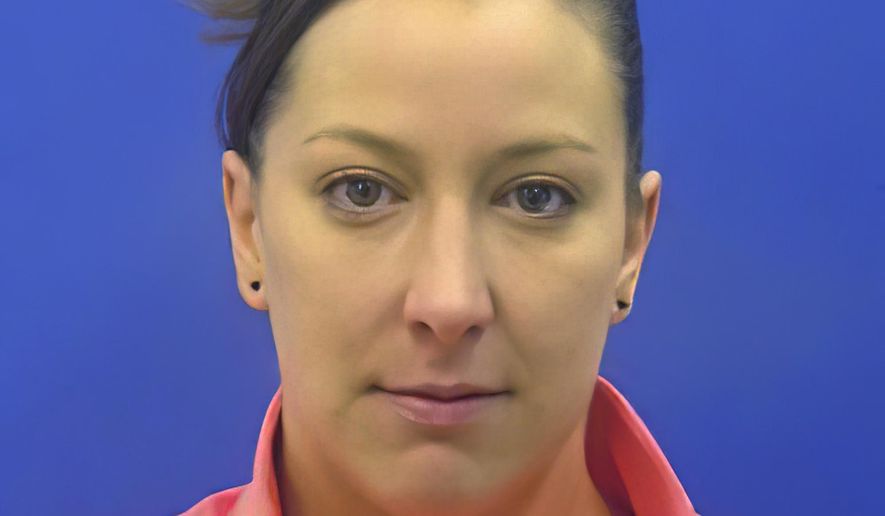More than two months after a U.S. Capitol Police officer shot and killed Ashli Babbitt during the Jan. 6 riot, the circumstances surrounding the shooting and the name of the officer who pulled the trigger remain shrouded in mystery.
Babbitt, a 35-year-old Air Force veteran, was unarmed when she was gunned down outside the House chamber. She was the only rioter killed by Capitol Police and the only person killed by gunfire that day.
Nearly 10 weeks later, authorities have not released the name of the officer who fired his weapon or disclosed why the officer opened fire.
There is no federal standard for releasing the names of officers involved in a fatal shooting.
However, police involved in other high-profile fatal encounters with unarmed civilians were quickly identified.
The Minneapolis Police Department identified the four officers involved in the death of George Floyd within two days of the incident.
Garrett Rolfe, the former Atlanta police officer who faces criminal charges arising from the death of Rayshard Brooks in June, was also identified within two days.
In response to the Black Lives Matter movement, some police departments have adopted a policy of releasing officers’ names to the public within 48 hours of a police-involved fatality.
It is not clear if the Capitol Police officer will face charges in Babbitt’s death.
The Wall Street Journal reported in early February that police investigators recommended no criminal charges against the officer. The report cited an anonymous law enforcement source.
The recommendation would not necessarily rule out criminal charges because the final decision rests with the U.S. Attorney’s Office for the District of Columbia.
On Monday, a spokesman for the District’s Metropolitan Police Department, which is overseeing the investigation, denied that a final decision had been made on criminal charges.
“The United States Attorney’s Office has not determined if charges will/will not be filed,” spokesman Dustin Sternbeck said in a statement to The Washington Times.
He declined to comment on whether the officer’s name will be released, saying the investigation remains active.
The Capitol Police is exempt from the Freedom of Information Act (FOIA), a law that requires federal agencies to disclose a large amount of information to the public. That leaves reports by the department’s inspector general that probe allegations of wrongdoing shielded from the public.
Other federal law enforcement agencies, including the FBI, Bureau of Alcohol, Tobacco, Firearms and Explosives, and Drug Enforcement Administration are subject to FOIA laws.
Local police departments also are required under their state’s sunshine laws to disclose information to the public.
The International Association of Chiefs of Police encourages local departments to quickly identify officers but did not recommend a specific time frame for public disclosure.
“The timely release of an officer’s name following an [office-involved-shooting] incident serves to enhance public trust in the investigative process and adds to the transparency and perceived integrity of the investigation,” the IACP wrote in a guidebook for police departments.
“Officers names’ will become public eventually so it is a matter of time of when, not if, an agency should release officer names,” the guidebook continued.
Babbitt, an ardent supporter of former President Donald Trump, was shot in the chest while trying to enter a restricted area known as the “Speaker’s Lobby” just outside the House chamber.
Her death was captured on video. It shows rioters breaking through Speaker’s Lobby’s glass doors, which were barricaded from the inside with chairs. As Babbitt tries to climb through the shattered glass, a gloved hand holding a gun enters the video frame and fires a shot into the crowd.
Babbitt immediately collapses after the gun goes off. The gloved hand holding a weapon is the only image of the officer in the video.
Babbitt, who came from California to attend Mr. Trump’s rally before the riot, was hailed as a martyr by some conservatives. Several Twitter accounts have popped up in her honor since her death.
The U.S. Capitol Police and U.S. Attorney’s Office for the District of Columbia would not comment for this article.
The officer was placed on leave during the investigation, according to a statement in January from Metropolitan Police and the Justice Department. That is standard procedure whenever a federal officer uses lethal force.
The officer remains in hiding, fearing for his safety, according to news reports that could not be confirmed by The Times.
Babbitt was among five people who died in connection with the Jan. 6 storming of the Capitol. Her death was one of the most violent.
Three other pro-Trump demonstrators died that day:
• Kevin Greeson, 55, of Alabama, died of a heart attack.
• Benjamin Philips, 50, of Pennsylvania, died of a stroke.
• Rosanne Boyland, 34, of Georgia, was trampled to death by a crowd outside the Capitol.
U.S. Capitol Police Officer Brian Sicknick clashed with rioters and later collapsed at the police station. He was taken to the hospital where he died the next day of a stroke, according to his family.
Federal prosecutors on Monday charged two men with assaulting Sicknick and two other officers with bear spray during the melee outside the Capitol.
Julian Elie Khater, 32 of Pennsylvania, and George Pierre Tanos, 39, of West Virginia, are each charged with one count of conspiracy to injure an officer, three counts of assault on a federal officer with a dangerous weapon, and a slew of minor trespassing charges.
They were not charged concerning Sicknick’s death. A cause of death for Sicknick has not been made public.
• Jeff Mordock can be reached at jmordock@washingtontimes.com.




Please read our comment policy before commenting.